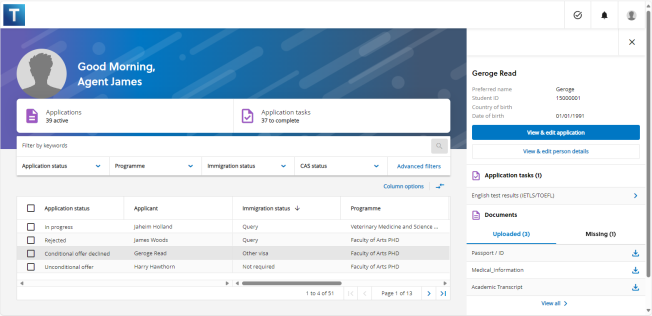Agents use the agent portal to process applications at their agency. Agents have access to all applications on a single page, allowing them to quickly check the status of applications, view identify outstanding tasks, and navigate the appropriate sections of applications to complete tasks. For example, upload missing documents or respond to offers. Permissions define the tasks that agents can perform.
Agent portal
Agents using the agent portal view a list of applications. Banners show the number of active applications and tasks. Active applications are applications with application statuses, such as Unconditional offer published and Conditional offer accepted. For information on the application statuses in the agent portal, go to Application status.
Agents can filter the list of applications to find applications of interest. The number of active applications and tasks is for the applications displayed in the list of applications and, therefore, reflects any filters applied. Applications can be assigned an agent responsible for managing the application. The list of applications can also be filtered by responsible agent.
Selecting an application in the list of applications shows the mini-info panel. The mini-info panel enables agents to quickly assess the current status of their applications and identify outstanding tasks that either they or the applicant need to complete for the admissions process to be completed.
The image Agent portal shows the agent portal with 39 active applications and 37 tasks, and the mini-info panel on the right-hand side showing the details of the selected application.
Agents can perform tasks on behalf of applications, such as downloading documents and responding to offers, as detailed in the table Agent tasks. Permissions define the tasks that agents can perform.
| Feature | Task |
|---|---|
|
Application details |
|
|
Applicant details |
|
|
Documents |
|
|
Offers and rejection |
|
|
Credit offers |
|
Application status
The agent portal simplifies the application status for agents. That is, the agent portal simplifies the various application statuses, such as using the status Conditional offer accepted for the statuses Conditional offer accepted and Condition offer insurance accepted.
The table Application status shows the application status in the agent portal, the corresponding status in Admissions, and whether the status means that the application is an active application in the agent portal.
| Agent portal | Admissions | Active? |
|---|---|---|
|
In progress |
Received (completion status) and no other application status is applicable. |
Yes |
|
Conditional offer |
Conditional offer published (decision 1) |
Yes |
|
Conditional offer accepted |
Conditional offer accepted (response 1) Conditional offer insurance accepted (response 1) |
Yes |
|
Conditional offer declined |
Conditional offer declined (response 1) |
No |
|
Unconditional offer |
Unconditional offer published (decision 2) Unconditional offer confirmed (decision 2) |
Yes |
|
Unconditional offer accepted |
Unconditional offer accepted (response 1) |
Yes |
|
Unconditional offer declined |
Unconditional offer declined (response 1) Unconditional offer declined (response 2) |
Yes |
|
Rejected |
Rejection published (decision 1) Rejection confirmed (decision 2) |
No |
|
Withdrawn |
Withdrawn |
No |
|
Ready for enrolment |
Sent to enrolment (completion status) |
No |
|
Closed |
Closed (completion status) |
No |
Agent portal settings
The agency settings define whether agencies are included, CC, in all correspondence with applicants. However, this does not include registration emails or acknowledgement emails. You need the relevant admissions settings permissions to view and edit the agency settings to include agencies in all correspondence. The agency shows in CC of the emails to applicants.
Agencies and agents
Agencies and agents are added to the reference data for applications. Agents have an account to log in to the agent portal. Administrators can define the permissions of agent accounts.
Agent accounts
Adding an agent automatically creates a person record and generates an invitation message using the communication template Agent portal registration email. The invitation email includes a link for the agent to create an account for the agent portal. Accounts are created and managed by Azure Active Directory B2C. That is, when agents follow the link to create an account, they receive a verification code from Azure Active Directory B2C before they can create a password. Agents then log in to the agent portal by selecting the Azure B2C login button.
The agent's profile allows you to view and manage the agent's details. The agent's profile also allows you to resend the invitation to the agent portal invite and to view the account history of the agent. Note that to view the agent profile, you need to search for the agent using the person search.
Permissions
After registration, agents are assigned to the role Agent applications viewer. You can define the permissions of role. For example, the permission Agent portal – View allows agents to view only the applications assigned to them. However, the permission Agent portal – View all allows agents to view all the applications at the agency. Agents with the permission Agent portal – View all and the permission Agent portal – Edit responsible agents can manage the responsible agents of applications at the agency.
Permissions then define the tasks that agents can perform as detailed below.
-
Applicant – Edit communication language to set the communication language of the applicant.
-
Applicant – Edit contact details to edit the contact details of the applicant.
-
Applicant – Edit emergency contact to edit the emergency contact details of the applicant.
-
Applicant – Edit personal details to edit the personal details of the applicant.
-
Application – Request deferral to request deferral.
-
Application – Request withdrawal to withdraw applications.
-
Application – Respond to offers to respond to offers
-
Documents – Edit to upload documents.
Demonstration
The video Agent portal shows how to view the applications, view the mini-info panel of an application, view an application, and assign a responsible agent to an application.
